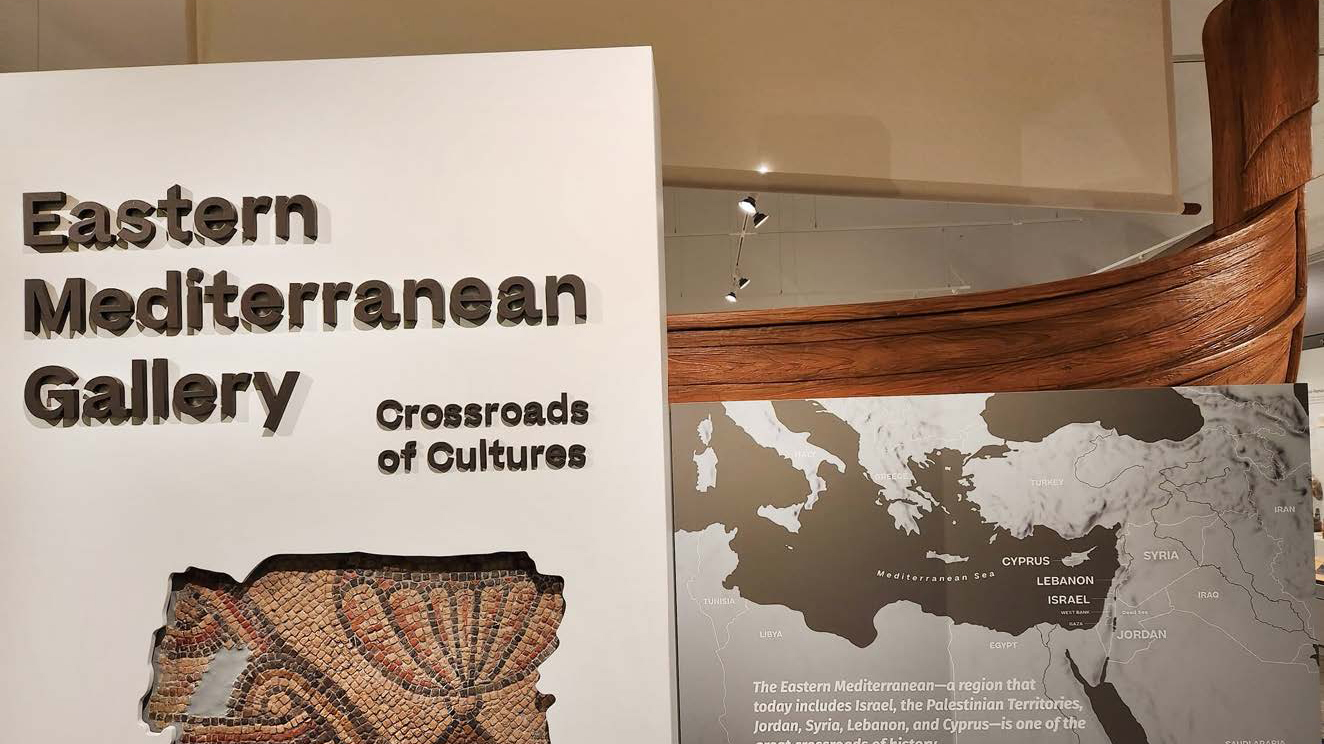Eastern Mediterranean Gallery Opens November 19: Penn Museum Reveals How Ancient Innovations Still Impact the World Today

PHILADELPHIA—The Penn Museum’s new Eastern Mediterranean Gallery: Crossroads of Cultures opens to the public on Saturday, November 19, 2022.
With nearly 400 artifacts from the Middle Bronze Age (2,000 to 1,600 BC) to the Ottoman Period (the 1800s), the Eastern Mediterranean Gallery showcases a cosmopolitan hub of diverse peoples collaborating across political, religious, and geographic lines. The gallery reveals how innovation was rooted for more than 4,000 years in the area that now encompasses Israel, Jordan, Lebanon, Syria, the Palestinian Territories, and Cyprus. This region still impacts the world today—from the origins of Judaism, Islam, and Christianity to the formation of the alphabet.
Through its three themes—Coexistence and Connection, Creativity and Change, and Power and Conflict —the reimagined 2,000-square-foot Eastern Mediterranean Gallery incorporates interactive, multi-sensory elements. With opportunities to touch replica artifacts, smell frankincense, and peer into animated reconstructions of an ancient city, visitors gain a new understanding of how their own lives are impacted by concepts first introduced in this region.
“This is a place of enormous significance for a lot of people in Philadelphia, because of its link to Christianity, Judaism, and Islam,” says Lead Curator Dr. Lauren Ristvet, Dyson Associate Curator, Near East Section. “As empires rose and fell over time, there was imperialism and civic resistance. But a lesser-told story is that this was a place of peaceful coexistence and great creativity."
One of the largest objects in the Eastern Mediterranean Gallery is the life-sized replica of part of a ship that sank in the Mediterranean Sea during the 14th century BCE. Its cargo hold is filled with pottery vessels and objects made of gold, bronze, copper, faience, glass, and ivory—evidence of international commerce and cultural exchange. Another monumental attraction in the gallery is a stela from 1270 BCE (Object: 29-107-958). A testament to Egyptian power, the stone marker depicts the Pharaoh Ramses II standing before the god Amun-Re.
Using documents, maps, drawing, and photographs from the Museum Archives chronicling the last 100 years, the gallery provides an in-depth look at Penn’s excavations, and sharing stories of local laborers, whose vital role has been historically overlooked.
“This is the only gallery in North America to address the Eastern Mediterranean’s political and colonial contexts. Similar to how the Museum approached the Africa Galleries, we’re confronting the fact that these excavations were part of particular moments in time with modern significance that are sometimes uncomfortable,” Dr. Ristvet adds.
“This new gallery showcases the Museum’s foundational excavations during the 20th century at the sites of Beth Shean, Gibeon, Tell es-Sa?idiyeh, and Kourion, allowing us to see tombs, temples, palaces, and houses as archaeological keys to unlocking the geographic, cultural, and political connections that defined this important crossroad of the ancient world,” says Penn Museum Williams Director Dr. Christopher Woods. “As our work in archaeology continually yields new discoveries, we think in new ways about history and recover the voices of people who shaped it.”
The gallery’s interactive elements make it accessible for visitors of all ages.
Filled with all-day activities, workshops, and live performances, the Gallery’s Opening Weekend celebration is Saturday, November 19 and Sunday, November 20, 2022.
Access to the Eastern Mediterranean Gallery is included with Museum admission.
###
About the Penn Museum
The Penn Museum’s mission is to be a center for inquiry and the ongoing exploration of humanity for our University of Pennsylvania, regional, national, and global communities, following ethical standards and practices.
Through conducting research, stewarding collections, creating learning opportunities, sharing stories, and creating experiences that expand access to archaeology and anthropology, the Museum builds empathy and connections across diverse cultures
The Penn Museum is open Tuesday-Sunday, 10:00 am-5:00 pm. It is open until 8:00 pm on first Wednesdays of the month. The Café is open Tuesday-Thursday, 9:00 am-3:00 pm and Friday and Saturday, 10:00 am-3:00 pm. On Sundays, the Café is open 10:30 am-2:30 pm. For information, visit www.penn.museum, call 215.898.4000, or follow @PennMuseum on social media.
Acknowledging Our Underwriters
The Eastern Mediterranean Gallery is made possible by the lead support of The Giorgi Family Foundation, and by additional generous support from the Frederick J. Manning, W69, family; J. Barton Riley, W70, and Gretchen P. Riley, CGS70; the David Berg Foundation; the McLean Contributionship; and Elizabeth R. McLean.
The Eastern Mediterranean Gallery has also been made possible by a major grant from the National Endowment for the Humanities: Democracy demands wisdom.



